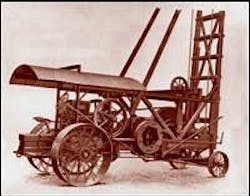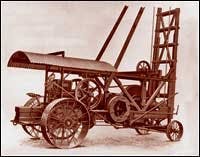Churn Drills Bored Early Holes
Bucyrus International makes some of the largest and most powerful shovels, walking draglines, and blast-hole drills in the industry. Under its former name of Bucyrus-Erie, it manufactured a wide range of excavating machines. In the early 1930s, Bucyrus was supplying excavating machinery to customers who often encountered hard rock on their jobs and expressed a clear need for a blast-hole drill. Lacking a drill in its product line, Bucyrus looked around for a suitable machine and, in 1933, purchased the Armstrong Manufacturing Co. together with manufacturing rights to its well-established line of drills.
Armstrong was the successor of several earlier drill manufacturers. Its heritage dated to 1868 when Kelly, Morgan & Co. was formed to satisfy drilling needs of local farmers. Through a succession of owners and name changes, the firm emerged in 1910 as the Armstrong Manufacturing Co. Armstrong was a leader in the drilling industry and had developed a highly successful line of churn-type drills for water well and blast-hole drilling as well as drill tools and bit dressers.
The churn drill, called a "Special Overhead Spudding Machine," was typical of the drills that contributed to the company's prosperity. The principle of churn drill operation was quite simple. The gasoline or electric power unit drove a crank arrangement through a belt drive. This imparted reciprocating action to the hoist rope, which caused the bit to be continuously raised and dropped in the hole to break up the rock, clay and sand particles. The drill bit consisted of a steel rod sharpened to a chisel point. Water poured into the drill hole and formed a slurry from the churning action of the drill bit and the drill cuttings.
Armstrong achieved many patents and innovations. It developed and patented a series of rubber-mounted shock absorbers in the derrick head to absorb the shock of the drilling tools. In 1922, Armstrong introduced self-propelled drilling rigs on traction wheels and, in 1927, steel framed rigs began to replace those with wooden frames. The first Armstrong self-propelled drills with crawler tracks appeared in 1932.
For some 10 years after the takeover, Bucyrus sold drills under the brand name Bucyrus-Armstrong. New models such as the W-series water-well drills and the T-series blast-hole drills were introduced, each incorporating the latest technology. Bucyrus introduced the first commercially successful large diameter rotary blast-hole drill in 1952. With compressed air as a bailing agent, the 50-R was the first in a long line of R-series blast-hole drills on which today's Bucyrus high-production drills are based. Rotary drills gradually replaced churn-type drills, which had been a successful product for the company with more than 11,600 sold up to 1984.
You can read more about the evolution of construction equipment in Keith Haddock's illustrated book "The Earthmover Encyclopedia" available in most bookstores or from Park Communications, call 403-931-1670. Also, consider a membership in the Historical Construction Equipment Association, www.hcea.net.

